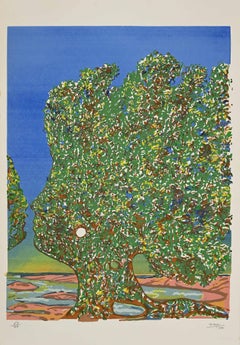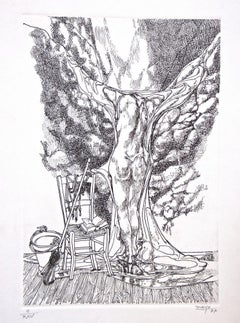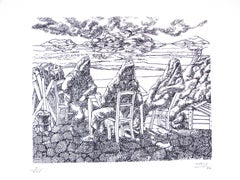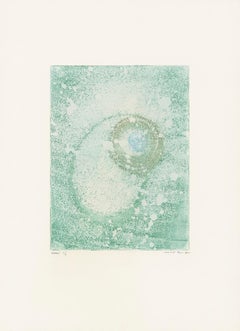Mayo (Antoine Malliarakis) Prints and Multiples
to
1
5
4
1
4
1
Overall Height
to
Overall Width
to
5
5
3
1
5
980
699
658
625
4
1
Artist: Mayo (Antoine Malliarakis)
L'Arbre de l'Amour (The Tree of Love) - Original Lithograph by Mayo - 1980
By Mayo (Antoine Malliarakis)
Located in Roma, IT
Beautiful hand signed lithograph by the Greek painter naturalized French citizen Antoine Malliarakis (Mayo, 1905-1990).
Edition 68/100, signed and dated in pencil lower right. Very ...
Category
1980s Surrealist Mayo (Antoine Malliarakis) Prints and Multiples
Materials
Lithograph
The Painter - b/w Etching - 1977
By Mayo (Antoine Malliarakis)
Located in Roma, IT
Image dimensions: 33x22.5 cm.
Edition of 25 prints, numbered and hand signed.
Very good conditions.
Category
1970s Surrealist Mayo (Antoine Malliarakis) Prints and Multiples
Materials
Etching
Personnage sans Tête - B/w Etching - Mid 1900
By Mayo (Antoine Malliarakis)
Located in Roma, IT
Personnage sans Tête is an original black and white etching on paper, realized by the artist Antoine Mayo, art name of Malliarakis (1905-1990)
Signed in pencil on lower right margin...
Category
Mid-20th Century Surrealist Mayo (Antoine Malliarakis) Prints and Multiples
Materials
Etching
Surrealist Nude - Original b/w Etching - 1977
By Mayo (Antoine Malliarakis)
Located in Roma, IT
Image dimensions: 33x22.5 cm.
Edition of 25 prints, numbered and hand signed.
Excellent conditions.
Category
1970s Surrealist Mayo (Antoine Malliarakis) Prints and Multiples
Materials
Etching
The Hooded - Original b/w Etching - 1977
By Mayo (Antoine Malliarakis)
Located in Roma, IT
Image dimensions: 23x28 cm.
Edition of 25 prints, numbered and hand signed.
Excellent conditions.
Category
1970s Surrealist Mayo (Antoine Malliarakis) Prints and Multiples
Materials
Etching
Related Items
"Terre des nébuleuses" by Max Ernst, Blue, Fog, Surrealism
By Max Ernst
Located in Köln, DE
Etching and aquatint in colours (colour variation) by Max Ernst.
"Terre des nébuleuses", 1965
38 x 27,5 cm
Copy essai 1/1
Category
1960s Surrealist Mayo (Antoine Malliarakis) Prints and Multiples
Materials
Etching, Aquatint
Marc Chagall - Daphnis and Chloé - Original Lithograph
By Marc Chagall
Located in Collonge Bellerive, Geneve, CH
Marc Chagall - Daphnis and Chloé - Original Lithograph
From the literary review "XXe Siècle"
1960
Mourlot N°227
Dimensions: 32 x 24 cm
Publisher: G....
Category
1960s Surrealist Mayo (Antoine Malliarakis) Prints and Multiples
Materials
Lithograph
H 12.6 in W 9.45 in D 0.04 in
Original Vintage Salvador Dali Exhibition Poster Featuring The Face Of Mae West
By Salvador Dalí
Located in London, GB
Original vintage advertising poster for a Salvador Dali exhibition at the Zurich Art House / Kunsthaus from 18 August to 22 October 1989 featuring a su...
Category
1980s Surrealist Mayo (Antoine Malliarakis) Prints and Multiples
Materials
Lithograph
Marc Chagall - The Candlestick - Original Lithograph
By Marc Chagall
Located in Collonge Bellerive, Geneve, CH
The Candlestick, from Jean Leymarie, Vitraux pour Jérusalem (Jerusalem Windows), André Sauret, Monte Carlo, 1962 (see M. 366-72; see C. books ...
Category
1960s Surrealist Mayo (Antoine Malliarakis) Prints and Multiples
Materials
Lithograph
Marc Chagall - The Tables of the Law - Original Lithograph
By Marc Chagall
Located in Collonge Bellerive, Geneve, CH
Marc Chagall - The Tables of the Law - Original Lithograph
1962
Printed by Mourlot
Dimensions: 32.5 x 24.5 cm
Publisher: André Sauret, Monte-Carlo
Reference: Mourlot n° 365
Unsigned...
Category
1960s Surrealist Mayo (Antoine Malliarakis) Prints and Multiples
Materials
Lithograph
H 12.8 in W 9.65 in D 0.04 in
After Pablo Picasso - Peace Circle - Lithograph
By (after) Pablo Picasso
Located in Collonge Bellerive, Geneve, CH
After PABLO PICASSO (1881-1973)
Peace Circle
Dimensions: 65 x 50 cm
Signed and dated in the plate
Edition Succession Picasso, Paris.
Editions de la Paix
Picasso is not just a man and his work. Picasso is always a legend, indeed almost a myth. In the public view he has long since been the personification of genius in modern art. Picasso is an idol, one of those rare creatures who act as crucibles in which the diverse and often chaotic phenomena of culture are focused, who seem to body forth the artistic life of their age in one person. The same thing happens in politics, science, sport. And it happens in art.
Early life
Born in Malaga, Spain, in October of 1881, he was the first child born in the family. His father worked as an artist, and was also a professor at the school of fine arts; he also worked as a curator for the museum in Malaga. Pablo Picasso studied under his father for one year, then went to the Academy of Arts for one year, prior to moving to Paris. In 1901 he went to Paris, which he found as the ideal place to practice new styles, and experiment with a variety of art forms. It was during these initial visits, which he began his work in surrealism and cubism style, which he was the founder of, and created many distinct pieces which were influenced by these art forms.
Updates in style
During his stay in Paris, Pablo Picasso was constantly updating his style; he did work from the blue period, the rose period, African influenced style, to cubism, surrealism, and realism. Not only did he master these styles, he was a pioneer in each of these movements, and influenced the styles to follow throughout the 20th century, from the initial works he created. In addition to the styles he introduced to the art world, he also worked through the many different styles which appeared, while working in Paris. Not only did he continually improve his style, and the works he created, he is well known because of the fact that he had the ability to create in any style which was prominent during the time.
Russian ballet
In 1917, Pablo Picasso joined the Russian Ballet, which toured in Rome; during this time he met Olga Khoklova, who was a ballerina; the couple eventually wed in 1918, upon returning to Paris. The couple eventually separated in 1935; Olga came from nobility, and an upper class lifestyle, while Pablo Picasso led a bohemian lifestyle, which conflicted. Although the couple separated, they remained officially married, until Olga's death, in 1954. In addition to works he created of Olga, many of his later pieces also took a centralized focus on his two other love interests, Marie Theresa...
Category
1950s Surrealist Mayo (Antoine Malliarakis) Prints and Multiples
Materials
Lithograph
H 25.6 in W 19.69 in D 0.04 in
Marc Chagall - Original Lithograph
By Marc Chagall
Located in Collonge Bellerive, Geneve, CH
Marc Chagall
Original Lithograph
1963
Dimensions: 32 x 24 cm
Reference: Chagall Lithographe 1957-1962. VOLUME II.
Condition : Excellent
Marc Chagall (born in 1887)
Marc Chagall was born in Belarus in 1887 and developed an early interest in art. After studying painting, in 1907 he left Russia for Paris, where he lived in an artist colony on the city’s outskirts. Fusing his own personal, dreamlike imagery with hints of the fauvism and cubism popular in France at the time, Chagall created his most lasting work—including I and the Village (1911)—some of which would be featured in the Salon des Indépendants exhibitions. After returning to Vitebsk for a visit in 1914, the outbreak of WWI trapped Chagall in Russia. He returned to France in 1923 but was forced to flee the country and Nazi persecution during WWII. Finding asylum in the U.S., Chagall became involved in set and costume design before returning to France in 1948. In his later years, he experimented with new art forms and was commissioned to produce numerous large-scale works. Chagall died in St.-Paul-de-Vence in 1985.
The Village
Marc Chagall was born in a small Hassidic community on the outskirts of Vitebsk, Belarus, on July 7, 1887. His father was a fishmonger, and his mother ran a small sundries shop in the village. As a child, Chagall attended the Jewish elementary school, where he studied Hebrew and the Bible, before later attending the Russian public school. He began to learn the fundamentals of drawing during this time, but perhaps more importantly, he absorbed the world around him, storing away the imagery and themes that would feature largely in most of his later work.
At age 19 Chagall enrolled at a private, all-Jewish art school and began his formal education in painting, studying briefly with portrait artist Yehuda Pen. However, he left the school after several months, moving to St. Petersburg in 1907 to study at the Imperial Society for the Protection of Fine Arts. The following year, he enrolled at the Svanseva School, studying with set designer Léon Bakst, whose work had been featured in Sergei Diaghilev's Ballets Russes. This early experience would prove important to Chagall’s later career as well.
Despite this formal instruction, and the widespread popularity of realism in Russia at the time, Chagall was already establishing his own personal style, which featured a more dreamlike unreality and the people, places and imagery that were close to his heart. Some examples from this period are his Window Vitebsk (1908) and My Fianceé with Black Gloves (1909), which pictured Bella Rosenfeld, to whom he had recently become engaged.
The Beehive
Despite his romance with Bella, in 1911 an allowance from Russian parliament member and art patron Maxim Binaver enabled Chagall to move to Paris, France. After settling briefly in the Montparnasse neighborhood, Chagall moved further afield to an artist colony known as La Ruche (“The Beehive”), where he began to work side by side with abstract painters such as Amedeo Modigliani and Fernand Léger as well as the avant-garde poet Guillaume Apollinaire. At their urging, and under the influence of the wildly popular fauvism and cubism, Chagall lightened his palette and pushed his style ever further from reality. I and the Village (1911) and Homage to Apollinaire (1912) are among his early Parisian works, widely considered to be his most successful and representative period.
Though his work stood stylistically apart from his cubist contemporaries, from 1912 to 1914 Chagall exhibited several paintings at the annual Salon des Indépendants exhibition, where works by the likes of Juan Gris, Marcel Duchamp and Robert Delaunay were causing a stir in the Paris art world. Chagall’s popularity began to spread beyond La Ruche, and in May 1914 he traveled to Berlin to help organize his first solo exhibition, at Der Sturm Gallery. Chagall remained in the city until the highly acclaimed show opened that June. He then returned to Vitebsk, unaware of the fateful events to come.
War, Peace and Revolution
In August 1914 the outbreak of World War I precluded Chagall’s plans to return to Paris. The conflict did little to stem the flow of his creative output, however, instead merely giving him direct access to the childhood scenes so essential to his work, as seen in paintings such as Jew in Green (1914) and Over Vitebsk (1914). His paintings from this period also occasionally featured images of the war’s impact on the region, as with Wounded Soldier (1914) and Marching (1915). But despite the hardships of life during wartime, this would also prove to be a joyful period for Chagall. In July 1915 he married Bella, and she gave birth to a daughter, Ida, the following year. Their appearance in works such as Birthday (1915), Bella and Ida by the Window (1917) and several of his “Lovers” paintings give a glimpse of the island of domestic bliss that was Chagall’s amidst the chaos.
To avoid military service and stay with his new family, Chagall took a position as a clerk in the Ministry of War Economy in St. Petersburg. While there he began work on his autobiography and also immersed himself in the local art scene, befriending novelist Boris Pasternak, among others. He also exhibited his work in the city and soon gained considerable recognition. That notoriety would prove important in the aftermath of the 1917 Russian Revolution when he was appointed as the Commissar of Fine Arts in Vitebsk. In his new post, Chagall undertook various projects in the region, including the 1919 founding of the Academy of the Arts. Despite these endeavors, differences among his colleagues eventually disillusioned Chagall. In 1920 he relinquished his position and moved his family to Moscow, the post-revolution capital of Russia.
In Moscow, Chagall was soon commissioned to create sets and costumes for various productions at the Moscow State Yiddish Theater...
Category
1960s Surrealist Mayo (Antoine Malliarakis) Prints and Multiples
Materials
Lithograph
De l'Origine des Espèces par Voie de Sélection Irrationelle: Visage
By Man Ray
Located in New York, NY
A very good impression of this color lithograph. Artist's proof, aside from the edition of 180. Signed and inscribed "EA" in pencil. Printed by Mourlot, Paris. Published by Leon Amie...
Category
1970s Surrealist Mayo (Antoine Malliarakis) Prints and Multiples
Materials
Color, Lithograph
Marc Chagall - The Ballet, Frontispiece
By Marc Chagall
Located in Collonge Bellerive, Geneve, CH
The Ballet, Frontispiece for the book “Daphnis and Chloe” Lithograph in colors, 1969. Unsigned and unnumbered, as issued from an edition of 10,000.
Printed ...
Category
1960s Surrealist Mayo (Antoine Malliarakis) Prints and Multiples
Materials
Lithograph
Marc Chagall - Original Lithograph
By Marc Chagall
Located in Collonge Bellerive, Geneve, CH
Marc Chagall
Original Lithograph
1963
Dimensions: 32 x 24 cm
Reference: Chagall Lithographe 1957-1962. VOLUME II.
Unsigned edition of over 5,000
Condition : Excellent
Marc Chagall (born in 1887)
Marc Chagall was born in Belarus in 1887 and developed an early interest in art. After studying painting, in 1907 he left Russia for Paris, where he lived in an artist colony on the city’s outskirts. Fusing his own personal, dreamlike imagery with hints of the fauvism and cubism popular in France at the time, Chagall created his most lasting work—including I and the Village (1911)—some of which would be featured in the Salon des Indépendants exhibitions. After returning to Vitebsk for a visit in 1914, the outbreak of WWI trapped Chagall in Russia. He returned to France in 1923 but was forced to flee the country and Nazi persecution during WWII. Finding asylum in the U.S., Chagall became involved in set and costume design before returning to France in 1948. In his later years, he experimented with new art forms and was commissioned to produce numerous large-scale works. Chagall died in St.-Paul-de-Vence in 1985.
The Village
Marc Chagall was born in a small Hassidic community on the outskirts of Vitebsk, Belarus, on July 7, 1887. His father was a fishmonger, and his mother ran a small sundries shop in the village. As a child, Chagall attended the Jewish elementary school, where he studied Hebrew and the Bible, before later attending the Russian public school. He began to learn the fundamentals of drawing during this time, but perhaps more importantly, he absorbed the world around him, storing away the imagery and themes that would feature largely in most of his later work.
At age 19 Chagall enrolled at a private, all-Jewish art school and began his formal education in painting, studying briefly with portrait artist Yehuda Pen. However, he left the school after several months, moving to St. Petersburg in 1907 to study at the Imperial Society for the Protection of Fine Arts. The following year, he enrolled at the Svanseva School, studying with set designer Léon Bakst, whose work had been featured in Sergei Diaghilev's Ballets Russes. This early experience would prove important to Chagall’s later career as well.
Despite this formal instruction, and the widespread popularity of realism in Russia at the time, Chagall was already establishing his own personal style, which featured a more dreamlike unreality and the people, places and imagery that were close to his heart. Some examples from this period are his Window Vitebsk (1908) and My Fianceé with Black Gloves (1909), which pictured Bella Rosenfeld, to whom he had recently become engaged.
The Beehive
Despite his romance with Bella, in 1911 an allowance from Russian parliament member and art patron Maxim Binaver enabled Chagall to move to Paris, France. After settling briefly in the Montparnasse neighborhood, Chagall moved further afield to an artist colony known as La Ruche (“The Beehive”), where he began to work side by side with abstract painters such as Amedeo Modigliani and Fernand Léger as well as the avant-garde poet Guillaume Apollinaire. At their urging, and under the influence of the wildly popular fauvism and cubism, Chagall lightened his palette and pushed his style ever further from reality. I and the Village (1911) and Homage to Apollinaire (1912) are among his early Parisian works, widely considered to be his most successful and representative period.
Though his work stood stylistically apart from his cubist contemporaries, from 1912 to 1914 Chagall exhibited several paintings at the annual Salon des Indépendants exhibition, where works by the likes of Juan Gris, Marcel Duchamp and Robert Delaunay were causing a stir in the Paris art world. Chagall’s popularity began to spread beyond La Ruche, and in May 1914 he traveled to Berlin to help organize his first solo exhibition, at Der Sturm Gallery. Chagall remained in the city until the highly acclaimed show opened that June. He then returned to Vitebsk, unaware of the fateful events to come.
War, Peace and Revolution
In August 1914 the outbreak of World War I precluded Chagall’s plans to return to Paris. The conflict did little to stem the flow of his creative output, however, instead merely giving him direct access to the childhood scenes so essential to his work, as seen in paintings such as Jew in Green (1914) and Over Vitebsk (1914). His paintings from this period also occasionally featured images of the war’s impact on the region, as with Wounded Soldier (1914) and Marching (1915). But despite the hardships of life during wartime, this would also prove to be a joyful period for Chagall. In July 1915 he married Bella, and she gave birth to a daughter, Ida, the following year. Their appearance in works such as Birthday (1915), Bella and Ida by the Window (1917) and several of his “Lovers” paintings give a glimpse of the island of domestic bliss that was Chagall’s amidst the chaos.
To avoid military service and stay with his new family, Chagall took a position as a clerk in the Ministry of War Economy in St. Petersburg. While there he began work on his autobiography and also immersed himself in the local art scene, befriending novelist Boris Pasternak, among others. He also exhibited his work in the city and soon gained considerable recognition. That notoriety would prove important in the aftermath of the 1917 Russian Revolution when he was appointed as the Commissar of Fine Arts in Vitebsk. In his new post, Chagall undertook various projects in the region, including the 1919 founding of the Academy of the Arts. Despite these endeavors, differences among his colleagues eventually disillusioned Chagall. In 1920 he relinquished his position and moved his family to Moscow, the post-revolution capital of Russia.
In Moscow, Chagall was soon commissioned to create sets and costumes for various productions at the Moscow State Yiddish...
Category
1960s Surrealist Mayo (Antoine Malliarakis) Prints and Multiples
Materials
Lithograph
Jean Cocteau - Europe's Construction - Original Lithograph
By Jean Cocteau
Located in Collonge Bellerive, Geneve, CH
Original Lithograph by Jean Cocteau
Title: Europe's Construction
Printed signature in the stone
Dimensions: 33 x 46 cm
Edition: 200
Luxury print edition from the portfolio of Sciaky
...
Category
1960s Surrealist Mayo (Antoine Malliarakis) Prints and Multiples
Materials
Lithograph
H 13 in W 18.12 in D 0.04 in
Dressed in the Nude in a Surrealist Fashion, from 1971 Memories of Surrealism
By Salvador Dalí
Located in Washington, DC
Artist: Salvador Dali
Title: Dressed in the Nude in a Surrealist Fashion
Portfolio: Memories of Surrealism
Medium: Etching and photolithograph
Date: 1971
Edition: AP XIV/XXV (artist'...
Category
1970s Surrealist Mayo (Antoine Malliarakis) Prints and Multiples
Materials
Etching, Lithograph
Free Shipping
H 29.75 in W 21.25 in
Mayo (antoine Malliarakis) prints and multiples for sale on 1stDibs.
Find a wide variety of authentic Mayo (Antoine Malliarakis) prints and multiples available for sale on 1stDibs. You can also browse by medium to find art by Mayo (Antoine Malliarakis) in etching, lithograph and more. Much of the original work by this artist or collective was created during the 20th century and is mostly associated with the Surrealist style. Not every interior allows for large Mayo (Antoine Malliarakis) prints and multiples, so small editions measuring 14 inches across are available. Customers who are interested in this artist might also find the work of Hanna Kay, Francis de Saint-Genies, and Roland Topor. Mayo (Antoine Malliarakis) prints and multiples prices can differ depending upon medium, time period and other attributes. On 1stDibs, the price for these items starts at $293 and tops out at $836, while the average work can sell for $446.





